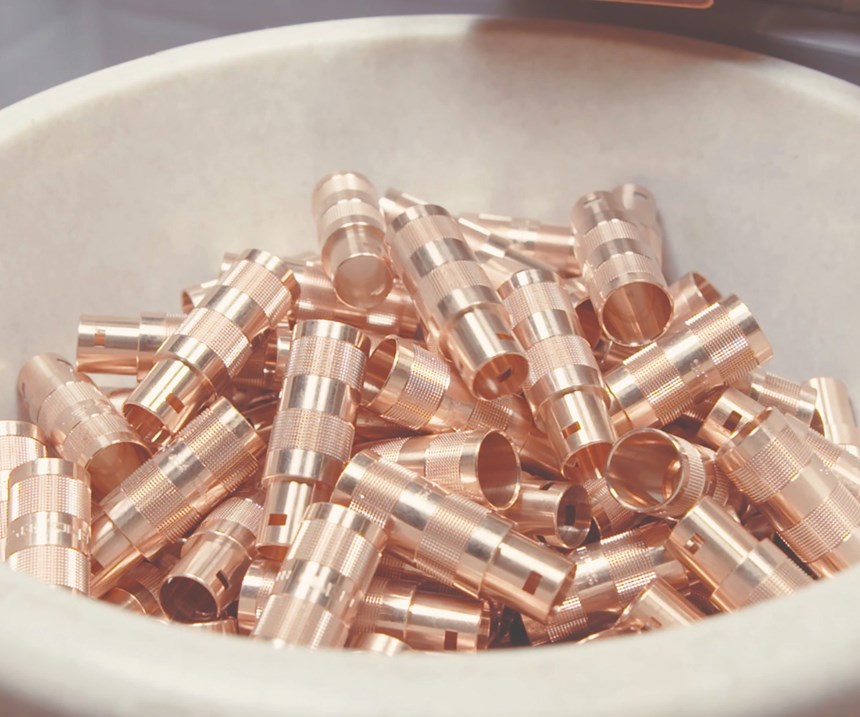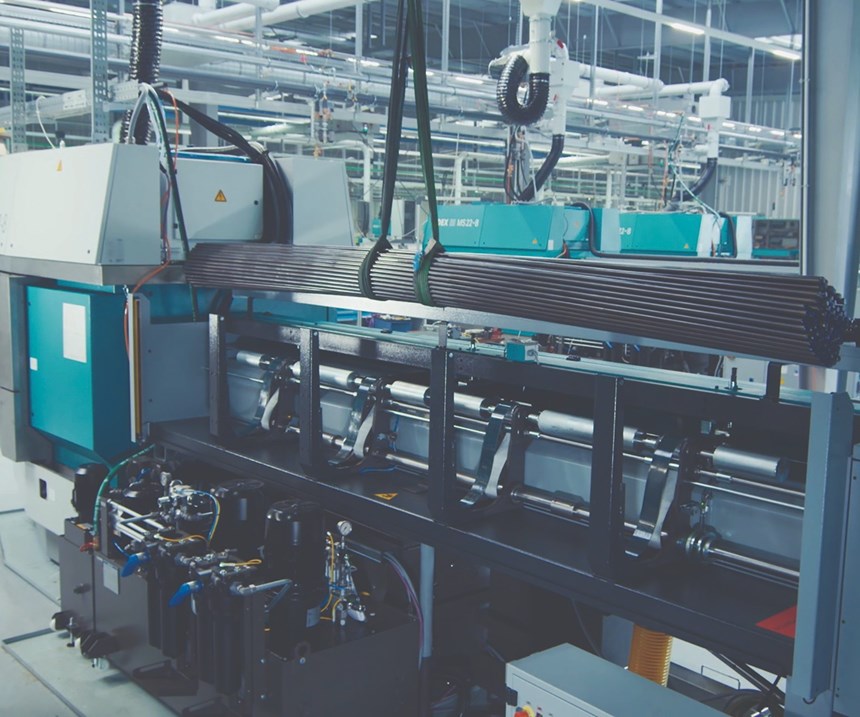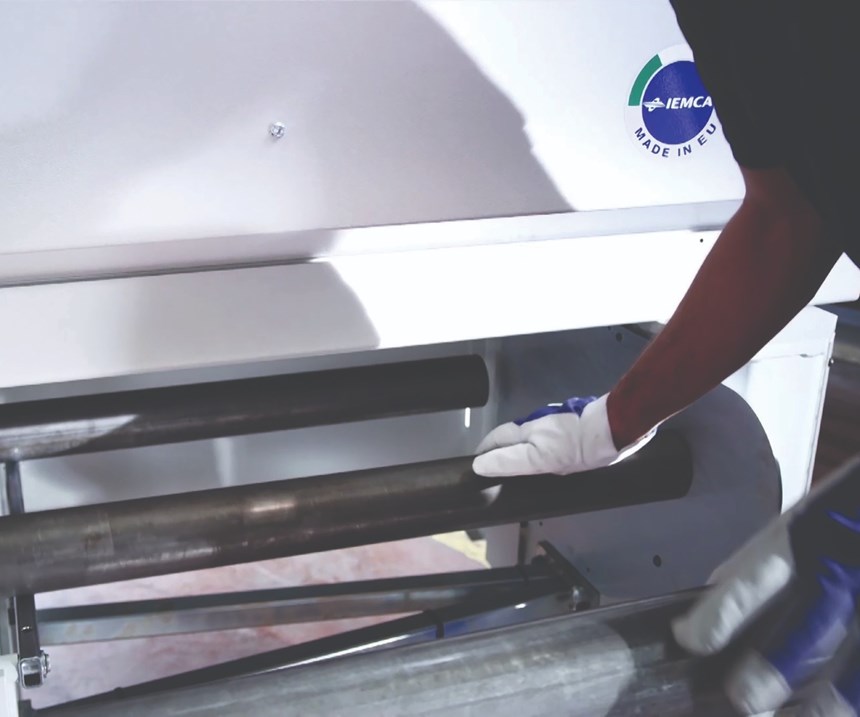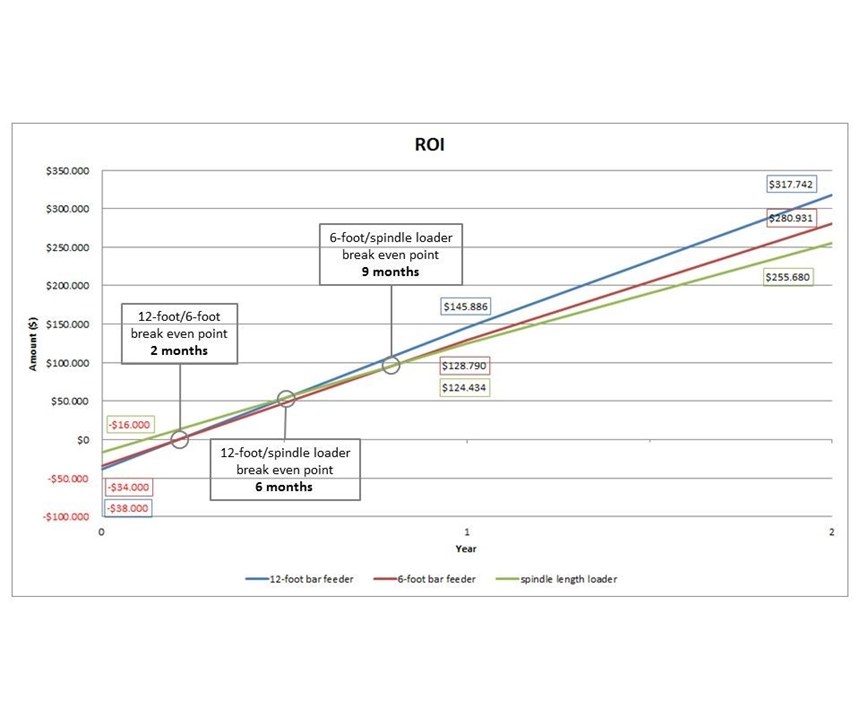Questions surrounding the availability of reliable, skilled labor, its cost and related liability issues are top-of-mind these days for manufacturers as the unemployment rates continue to plummet. Shop owners are looking for creative ways to increase productivity and reduce labor, and automation is considered in every new project. For turning operations, bar feeding brings the biggest bang for the buck, but a shop needs to select the bar feeder type that best suits its needs.
By most estimates, short bar feeders are the most popular type, accounting for about half of all bar feeders sold in the United States and about 35 percent of total dollar sales. Full-size magazine-style bar feeders account for about 30 percent of total unit sales in the U.S. and about 35 percent of total dollar sales. The numbers are different in Europe, where full-size bar feeders are the rule, and short bar feeders are comparatively rare. The numbers may be interesting, but, unfortunately, they cannot help a shop in its decision. Run sizes, part diameters, types of materials, accuracy requirements, the need for unattended machining capabilities, and other like considerations will determine the type of bar feeder that is best for each shop. Each type of bar feeder has unique advantages that must be weighed against the shop’s specific needs. Here are the top considerations.
Lot Size
What lot sizes will typically be run on the lathe? If the CNC lathe will be used primarily for short-run work with frequent setup changes, the spindle-length bar feeder is the more logical choice. On such bar feeders, the entire length of the bar is fed into the lathe spindle at the onset. With small lots, having a high volume of material to be worked is not critical, thus, in most cases, the limited capacity of a spindle length bar feeder will be enough to cover the capacity needed for the job.
The short bar feeder can be considered for a large run in cases where extruded or shaped materials need to run at high rpm and straightness can be a problem. When short lengths of such materials are completely contained in the lathe spindle, they can be rotated at full rpm for machining without vibration problems because all the bar will be contained in the spindle. In general, the short bar feeder is more forgiving of unbalanced (non-symmetrical) extrusions and bent or bowed bars that would otherwise cause vibration.
If production quantities are large, and productivity and getting the most pieces from the bar are important, the lathe owner will probably benefit more from the 12-foot-capacity magazine-style bar feeder. From the standpoint of productivity, using long bars can help reduce labor costs because the machine can be left unattended for longer periods. One operator can tend two or three such machines. The machines are less likely to run out of material, thus idling 10 minutes here, 15 minutes there and so on.
Material Waste Factors
Where maximum material utilization is important, the 12-foot-capacity bar feeder is a good choice because the entire bar is converted to usable parts except for a single remnant. By contrast, when a 12-foot-long bar is cut into three or four lengths that will be loaded in a spindle-length bar feeder, an equivalent number of remnants is produced, which means fewer parts per 12-foot bar and more scrap.
Lathe Spindle Length
The length of the lathe spindle is not a factor when considering a 12-foot-capacity bar feeder. However, it cannot be ignored when considering the spindle-length bar feeder. Many CNC bar machines have spindles into which short bars as long as 4 feet can be completely inserted. Such lathes can accommodate 3- and 4-foot lengths cut from standard 12-foot bars. Material loss to remnants from the short bars is several times more than the loss from a continuous 12-foot bar.
Part Length Considerations
The 12-foot magazine-style bar feeder typically delivers better material utilization than the spindle-length bar feeder. Regardless of part length, material loss from a continuous 12-foot bar is limited to one remnant. However, as part length increases on a lathe served by a spindle-length bar feeder, the remnants left from each of three or four short lengths cut from a continuous 12-foot bar can represent a significant percentage of the bar.
If the job involves washer-like parts, a 3-foot bar may last for an hour. However, if the job involves motor shafts, the lathe can go through a 3-foot bar in minutes, and then it must pause while the next short bar is loaded. The amount of time it takes for the short bar feeder to load the short lengths of bar into the lathe can drag down production rates for the part as well.
Magazine Design
Shops that plan to run their CNC bar machines unattended overnight, during holidays and over weekends face other concerns. Running unattended imposes a number of special requirements, not the least of which is the ability to supply the machine with enough raw material to continue running for the intended period. The amount of time the lathe can run unattended, assuming all other systems are functioning properly, depends on how much material the bar feeder’s magazine can hold.
Plant Layout
In situations where floor space is at a premium, the spindle-length bar feeder is usually preferred because it only takes up about half of the space required for a 12-foot-capacity bar feeder. The savings in floor space may not be that great for a single bar feeder, but where a multiple-machine installation is involved, the space savings can frequently be enough to permit installing one or more additional lathes and bar feeders than would otherwise be possible.
Many companies that buy spindle-length bar feeders do so because they believe they do not have the room for a 12-foot-capacity bar feeder. However, bar feeder suppliers make the point that once prospective buyers calculate the advantages of the 12-foot-capacity bar feeder over the spindle-length bar feeder in terms of productivity gains and increased material utilization, they somehow find the room for the larger unit.
Cutting Speeds
Historically, shops that operated bar machines have had a problem controlling the whip and vibration that occur in a long bar when it is rotated at high speed. The main causes of the problem have included difficulty of controlling a closely confined bar rotating at speeds of up to 10,000 rpm and the lack of uniformity in the bar material itself. Ironically, while lathe builders increased the spindle speeds of their machines to improve productivity, shop owners had to cut back on spindle speed to minimize the effects of vibration on such things as accuracy, surface finish and tool life.
Today the situation is much improved. Better bar feeder design plus more widespread use of centerless-ground barstock have made it possible for 12-foot-capacity bar feeders to feed 12-foot bars as much as 2 inches in diameter at or near maximum spindle speeds. Users of such bar feeders no longer must sacrifice spindle speed to get productivity with good material utilization.
Minimization of Spindle Downtime
The amount of time required to change over the bar feeder to feed a different bar diameter is another important consideration. The spindle-length bar feeder has the edge here because of its simpler operation. Typically, the spindle-length bar feeder can be changed over to run a different bar diameter in 5 to 10 minutes, assuming the correctly sized spindle liner is available. Most of that time is taken up in removing the liner from the lathe spindle and replacing it with one that more closely matches the diameter of the barstock for the next job.
The fast change-over time of the spindle-length bar feeder is an important advantage for shops that do a lot of short-run work. The short bar lengths are lighter, less awkward and less fatiguing to handle than 12-foot bars, which also helps speed the change-over.
Changing from one bar diameter to another on a 12-foot magazine-style bar feeder can take from 45 minutes on older units to as little as 5 minutes on newer bar feeder designs. Change-over time depends primarily on whether or not the guide channel, which supports and confines the bar as it rotates in the bar feeder, needs to be changed. If the bar size for the next job to be run is similar to that for the job just finishing, the same guide channel may be used, shortening the setup time. If the guide channel must be changed, the setup can take twice as long, however, newly developed bar feeder technology focuses on reducing this change-over time and occurrence.
Shopfloor Logistics
Shops need to get the most from their employees, and an important step in achieving this peak performance includes providing an environment that keeps employees interested in their work and minimizes the potential for injuries on the job. Since less manual bar handling is involved in using full-length, magazine-style bar feeders, operators have fewer smashed fingers, strained backs and similar injuries. In fact, with today’s bundle loaders, a 5,000-pound bundle of bars can be delivered by overhead crane directly to the bar feeder and never touched by shop personnel. Operators are then freed to do more productive tasks such as running several machines and monitoring part quality.
Cost of Ownership
For shops that regularly schedule short-run jobs and need to be able to accommodate a range of part diameters, the spindle-length bar feeder can be a great fit and will fit most budgets. While the 12-foot-capacity magazine-style bar feeder might be twice the cost up front, shops with high-volume jobs may find this option a better value as it helps to maintain competitive pricing through good production rates and low scrap ratios.
A shop can use the spindle-length bar feeder for high-volume work (many do), perhaps on the theory that the savings on the purchase price more than makes up for a little less yield per 12-foot bar and a slightly slower production rate. As the graph above shows, however, when a spindle-length bar feeder is used for high-volume work, the average total return on investment becomes the same as that of a 12-foot-capacity bar feeder at six months. Comparing the 12-foot-capacity design to a 6-foot model shows an even more dramatic difference, with the breakeven point at only two months.
The Final Decision
For those shops in the market for a magazine-style bar feeder, these guidelines should be useful in correctly choosing between a spindle-length bar feeder and a 12-foot-capacity bar feeder. A shop should closely consider its specific needs as they relate to the advantages of each bar feeder type and the relative impact that such automation solutions may have on labor before committing to the investment.
Related Content
Job Shop Discovers and Fills a Fishing Need
The promise of a product line for improved mounting of electronic fish finders led this Missouri job shop to an automated turning process.
Read MoreInside the Premium Machine Shop Making Fasteners
AMPG can’t help but take risks — its management doesn’t know how to run machines. But these risks have enabled it to become a runaway success in its market.
Read MoreUnattended Production Takes More Than the Most Capable CNC Machine
Process planning and reliable peripherals are key to successful lights-out manufacturing.
Read MoreAutomation in the Alps: Studer AG Unveils New Grinding Concepts
Studer AG, member company of United Grinding, held its annual press conference at its Swiss Alps location earlier this month to announce its new automatic loaders to accompany its existing grinding machines as well as other offerings and automation features.
Read MoreRead Next
Peak Performance in the Machining Lab
Matching the right equipment for the job and having quality employees to handle the work is paying big dividends for this precision shop.
Read More5 Aspects of PMTS I Appreciate
The three-day edition of the 2025 Precision Machining Technology Show kicks off at the start of April. I’ll be there, and here are some reasons why.
Read MoreEmerging Leaders Nominations Now Open
Here’s your chance to highlight a young person in your manufacturing business who is on the path to be a future leader moving your company forward.
Read More



























